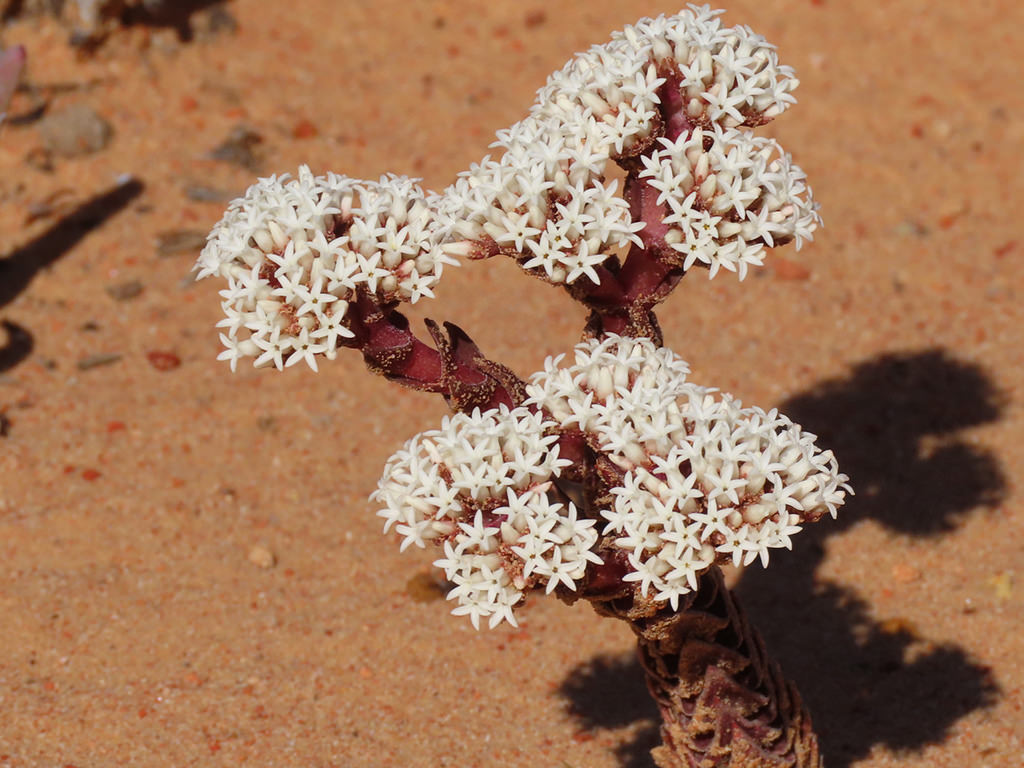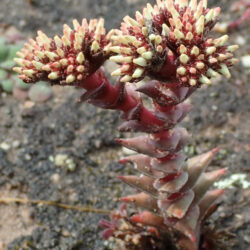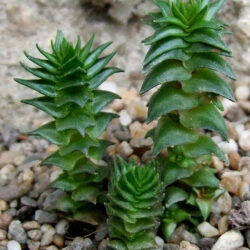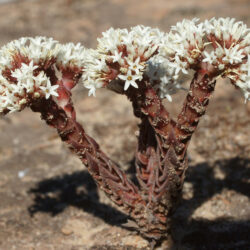Crassula alpestris is a unique plant with sand-covered leaves, a survival feature that helps it tolerate temperature extremes in its native habitat.
Scientific Name
Crassula alpestris L.f.
Common Name(s)
Alpine Stonecrop, Sand-coated Crassula
Synonym(s)
Crassula alpestris subsp. alpestris, Purgosea alpestris, Tetraphyle alpestris
Scientific Classification
Family: Crassulaceae
Subfamily: Crassuloideae
Genus: Crassula
Etymology
The specific epithet "alpestris (al-PES-triss)" means "Alpine, relating to high mountains," and refers to the native habitat of the species.
Origin
Crassula alpestris is native to South Africa. It grows in sandy soil in shallow rock pockets in the mountains of the Western Cape and Northern Cape provinces.
Description
Crassula alpestris is a small succulent with fleshy, triangular, often overlapping leaves with a broad base that clasps the stems. It can grow solitary or sparingly branched, reaching up to 6 inches (10 cm) in height, including inflorescence. The stems are upright, fleshy, red, and up to 0.2 inches (0.5 cm) in diameter. The leaves can reach up to 0.8 inches (2 cm) in length and 0.25 inches (0.6 cm) in width at the base, tapering to a sharp point. They are arranged in opposite pairs, each pair at 90 degrees to the pair above and below, resulting in a square-stemmed appearance.
The flowers have a sweet fragrance and appear in dense clusters at the top of mature stems in winter. They are urn-shaped, about 0.2 inches (0.5 cm) in diameter, with a tube of fused petals that open widely with recurving tips. The petals are white, sometimes tinged with pink or red. The fruits are small capsules that contain tiny, black, dust-like seeds. This plant is monocarpic, which means that after flowering, the stem dies.

How to Grow and Care for Crassula alpestris
Light: Crassula alpestris prefers full sun to partial shade. However, avoid intense afternoon sun during the hot summer days, as it can burn the leaves. If you are growing this plant Indoors, place it in a window with at least 6 hours of direct sunlight.
Soil: This plant is not particular about soil pH, but it does require soil that is very porous and has excellent drainage. You can use commercial soil mix for succulents or create your own.
Temperature: While this succulent can tolerate average summer temperatures and short-term freezing, extreme cold or heat can cause it to lose leaves and even die. Crassula alpestris grows best in USDA Plant Hardiness Zones 9b to 11b, with average minimum winter temperatures ranging from 25 to 50 °F (-3.9 to 10 °C).
Watering: Avoid overwatering using the "soak and dry" method to keep the plant healthy. Water deeply and then let the soil completely dry out before watering again. Reduce watering in winter. The potted plants require more frequent watering than those in the ground.
Fertilizing: While Crassula alpestris does not require high levels of nutrients, it will benefit from a small amount of organic fertilizer in mid-spring when it starts actively growing.
Repotting: Repot the plant as needed, preferably in spring, at the beginning of the growing season. Make sure the soil is dry before beginning to repot.
Propagation: A fast way to get a decent-sized plant is by stem cuttings during the growing season. You can also propagate Crassula alpestris from leaves. If you prefer to start the plant from seeds, it is best to sow them during spring or summer.
Learn more at How to Grow and Care for Crassula.
Toxicity of Crassula alpestris
Crassula alpestris is considered non-toxic and is safe for growing around children and pets.
Links
- Back to genus Crassula
- Succupedia: Browse succulents by Scientific Name, Common Name, Genus, Family, USDA Hardiness Zone, Origin, or cacti by Genus
Photo Gallery
Click on a photo to see a larger version.



